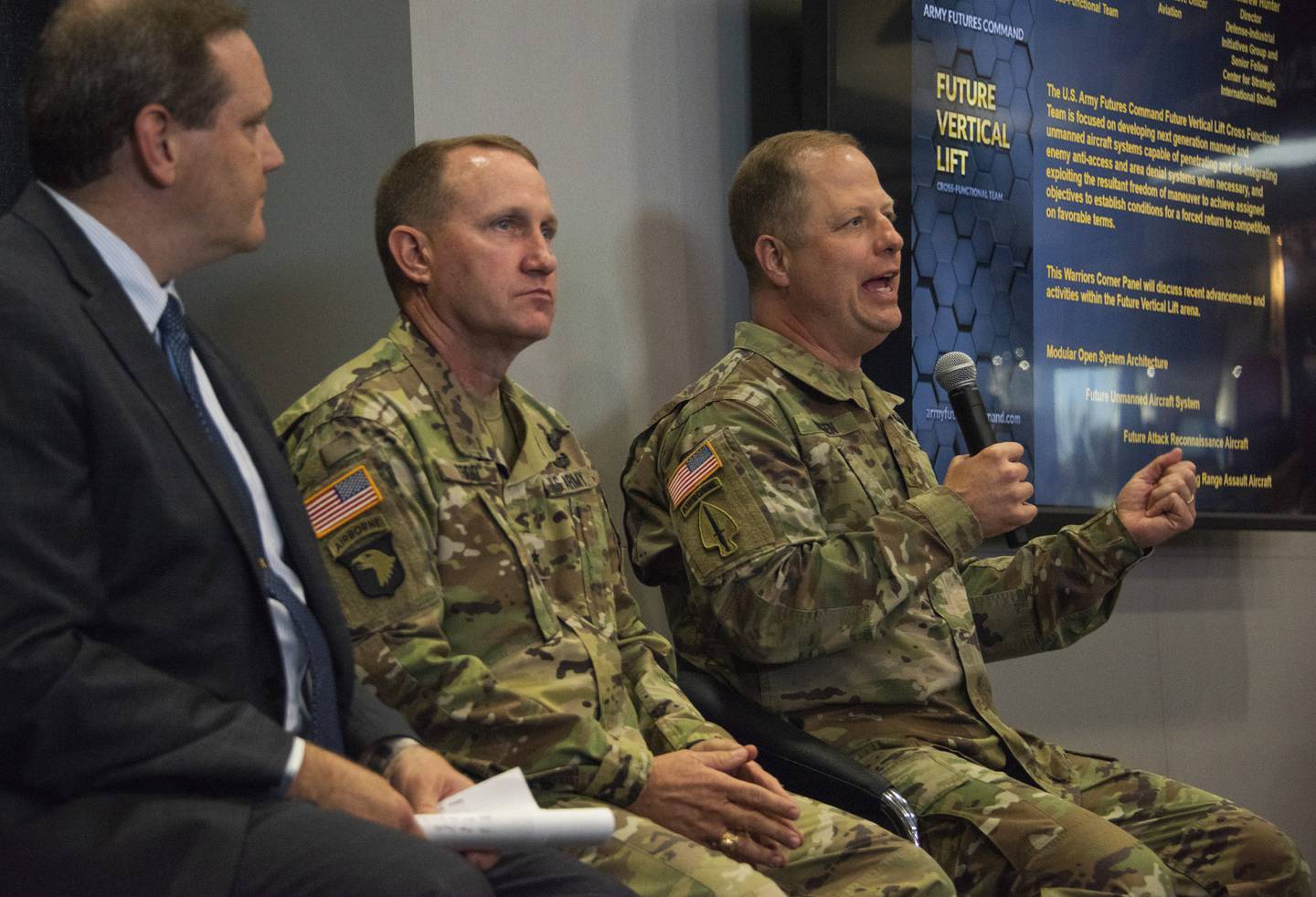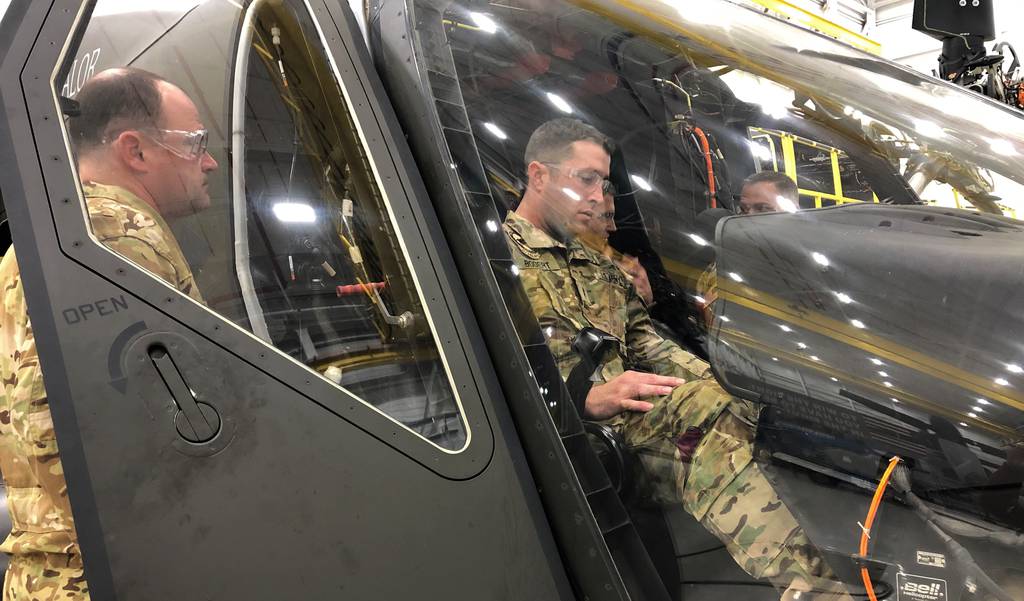WASHINGTON — The U.S. Army can simultaneously field two clean sheet-designed future vertical lift aircraft, assuming costs remain affordable, according to an Oct. 6 report by the Center for Strategic and Budgetary Assessments.
“In many ways, affordability begins with simply living within one’s means rather than optimistically estimating future cost savings that never materialize,” read the report, which was obtained by Defense News in advance of its release. “This approach starts with realistic program cost estimates and program strategies.”
Being realistic and reducing uncertainty, the report stressed, “will increase confidence and trust in the program.”
The Future Vertical Lift program to procure both a future long-range assault aircraft (FLRAA) and a future attack reconnaissance aircraft (FARA) at nearly the same time is ambitious, considering the Army’s failure to get a clean-sheet helicopter design across the finish line since it brought the UH-60 Black Hawk utility helicopter and AH-64 Apache attack helicopter programs into the fleet more than 40 years ago. The FLRAA and FARA both have fielding goals of 2030.
The Army experienced several failures over the last 20 years attempting to replace its OH-58D Kiowa Warrior with the RAH-66 Comanche and the ARH-70 Arapaho, followed by an attempt almost a decade ago to look at commercial off-the-shelf capabilities. Those events have observers wondering whether the service is even capable of seeing a singular aircraft through, let alone an effort that pursues two at the same time.
Cost comparisons
Drawing comparisons with the last time the Army procured two helicopters simultaneously — the Black Hawk and Apache — the report examined funding allocated over three phases of acquisition: research, development, testing and evaluation; procurement; and operations and support.
For both the UH-60 and AH-64, RDT&E funding stayed lower during early development but increased over time as the Army bought aircraft.
The AH-64 and the UH-60 consumed 0.03 percent of the Army’s budget top line in fiscal 1971 and 3.2 percent in fiscal 1990. The average across the period of time is 1.6 percent. Procurement funding for the two aircraft together took up on average 4.5 percent, the report said.

“Based on the data, FVL’s ability to be affordable may be to ensure that combined spending on FARA and FLRAA for RDT&E, procurement and O&S consumes approximately 1.6 percent of the Army’s annual topline, on average,” the report concluded.
And FVL will “enhance its affordability” if spending on both FARA and FLRAA procurement combined takes up approximately 4.5 percent of the Army’s annual procurement budget on average.
Maj. Gen. Wally Rugen, who is in charge of the Army’s FVL modernization and oversees the FARA and FLRAA programs, told Defense News in a recent interview that he believes the program can live within the means laid out in the report.
“Our assessments are that we are below that 1.6 percent and that 4.6 percent,” Rugen said. “We have to live with that, below our means, and our program has to stay there to maintain affordability.”
The Army is doing that through investments in modular open-systems architecture, or MOSA, he said, as well as reformed acquisition methods such as special contracting mechanisms to conduct competitive prototyping to inform what is technically possible and assess capability across the life cycle.
The report noted that FVL will not “automatically become unaffordable if its relative costs exceed these benchmarks. Nor will it automatically remain affordable if its relative costs fall below these benchmarks.”
The benchmarks “indicate the opportunity costs that the Army proved willing to incur previously to obtain two new helicopters,” the report said. “The Army may prove willing to incur greater or fewer opportunity costs to acquire FARA and FLRAA.”
Driving affordability
The Army insists there is a need to field new aircraft and begin retiring legacy systems by 2030 because Russia and China are not slowing their own technological developments. The service says it needs aircraft capable of flying faster and at much longer ranges to effectively operate in theaters like the Indo-Pacific region.
The service has also spent well over a decade developing technology ahead of FARA and FLRAA through both studies and two flying demonstrators in the Joint Multi-Role Technology Demonstrator program.
The factor that could ultimately derail the program, therefore, is not technology or an appetite for the aircraft, but rather the cost.
One of the newer ways the Army is doing business within the FVL program — and which is critical to its success — is the adoption of MOSA. That approach is essentially “shared design standards and common interfaces to support technology insertion for system and component upgrades,” the report explained.
“The critical but uncertain link between MOSA and affordability will continue to be important for FVL,” the report added, and MOSA and digital engineering should be harnessed to live within the service’s means.
The report acknowledged that efforts to date within the FVL program have mitigated programmatic risk through technology demonstrations starting well over a decade ago. Used to the Army’s advantage, MOSA will boost industry competition as well as make it easier to increase mission flexibility and rapidly upgrade, according to the report.
MOSA could also reduce long-term operations and sustainment costs, which often account for the larger percentage of a program’s cost — roughly 70 percent — over its life cycle, the report found.
CSBA noted that while MOSA proponents tout potential cost savings, it believes that “it may be more likely to enhance opportunities to avoid cost growth, which promise significant lifecycle savings.”

According to Rugen, “this digital approach gives us an opportunity to address the real critical path on affordability.”
Both Rugen and the report point to the unmanned aircraft era as a good example of how modular, open systems and digital engineering shifted some of the cost of the overall program out of operations and sustainment. They also noted that the FVL programs could be more similar than to a conventional helicopter program.
Additionally, more investments up front in MOSA “would actually have a positive effect on reducing O&S downstream in the program lifecycle costs,” the report stated.
In creating an “open ecosystem,” MOSA would “help avoid costly and time-consuming redesign to accommodate both hardware and software upgrades by making standards and interfaces readily available,” it added.
Reducing risk
The report also made recommendations to help the Army avoid risk and execute the program.
The service, for instance, should be careful solidifying requirements of FLRAA and FARA separately. The report pointed out that the Kiowa, which was meant to be the scout for the Apache, was slower than the Apache, which limited full operational potential.
The report also warned the Army not to feel pressured to speed up the program schedule, as that could result “in pressure to resort to a development timeline based on concurrence (of development and production), which has routinely proven detrimental to defense acquisition programs.”
The Army should consider splitting the FVL ecosystem into three major elements: platforms and airframes; mission systems; and payloads, weapons and offboard effects. And the service should avoid using a block upgrade approach because it promotes rigid timelines and additional program management overhead.
“Instead, the ecosystem should execute a periodic and incremental approach,” the report stated.
The Army should also have a clear understanding of the state of the industrial base and the impact that choosing a single winner could have on both platforms.
Rugen said the Army will choose “the best” aircraft for each program and not be influenced by the implications of choosing one vendor or different vendors for each aircraft.
Jen Judson is an award-winning journalist covering land warfare for Defense News. She has also worked for Politico and Inside Defense. She holds a Master of Science degree in journalism from Boston University and a Bachelor of Arts degree from Kenyon College.








